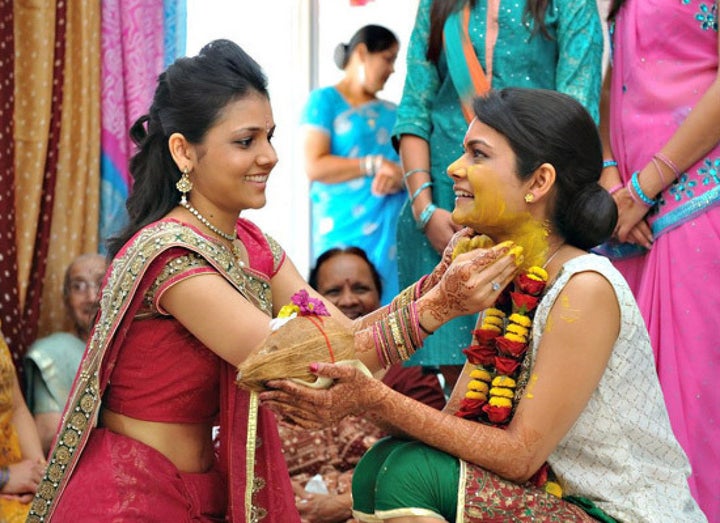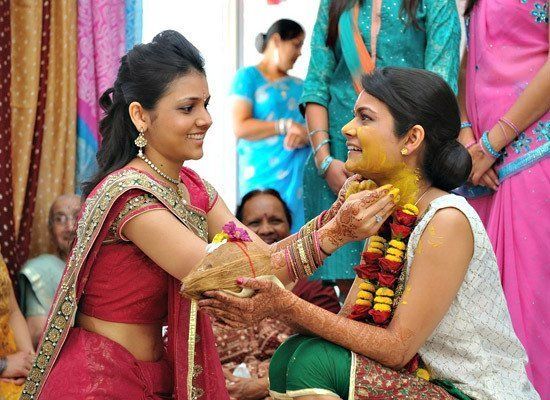
Indian weddings have always been known for their grandeur and fun atmosphere, but when it comes to planning them, it's a whole different ball game. With the amount of events leading up to the wedding and the what-seems-like 40 different rituals within the ceremony itself, it can be overwhelming for brides-to-be.
So let's break it down. Remember, because of the numerous sub-cultures within the country, there are several different versions of what people consider to be an "authentic" Indian wedding. Below is a loose guide, but keep in mind there are many other traditions out there!
(Scroll down for photos)
Pre-wedding rituals
Pre-wedding rituals are crucial in Indian weddings. They are considered to be auspicious and promising for the forthcoming wedding. Generally, these rituals last about a week, creating excitement and cheer among relatives and close friends. Below are the two main pre-wedding rituals that are celebrated across the country:
Pithi: The pithi ceremony is an auspicious ritual performed for good luck. Generally, the bride and groom have separate pithi ceremonies at their family homes. Pithi is a paste made mainly of turmeric, chickpea flour and rose water. Family members and well-wishers of the bride and groom apply the paste on the bride/groom's skin. This yellow paste is thought to brighten and even the skin tone and is applied on one of the days prior to the wedding ceremony.
Mehndi: The Mehndi event is a colorful celebration held the night before the wedding, which is traditionally celebrated by the women on the bride's side of the family. Generally, a professional mehndi artist or relative will apply henna in intricate designs to the hands and feet of the bride and other women in the family. These intricate designs symbolize joy, beauty, spiritual awakening and offering. Guests create a festive atmosphere by dressing in bright colors, singing traditional wedding songs, and dancing to popular music.
Wedding ceremony
A traditional wedding ceremony consists of a series of religious rituals that unite not only the bride and groom, but also their families. In the Indian culture, maintaining close ties with immediate and extended family is crucial. For most Indians, family plays a key role in making life decisions.
The wedding ceremony begins with the arrival of the groom.
Baraat (The Groom's Procession): Accompanied by his family and friends in a festive procession known as the baraat, the groom arrives at the entrance of the wedding venue on a horse. The procession consists of his family and friends singing and dancing around him to music generally played by a professional dhol (large bass drum) player. The baraat is met by the bride's family at the entrance to the wedding venue.
Milni (Meeting of the Families): The bride's mother greets the groom with a welcoming ritual. Relatives of the bride and groom embrace and greet each other with garlands. The bride's family then escorts the groom to the mandap, a canopied altar where the ceremony is performed. The mandap represents the home that the bride and groom will make together.
Ganesh Puja (Prayer to Lord Ganesh): The ceremony begins with a worship of Lord Ganesh, the destroyer of all obstacles. The priest guides the groom and bride's parents in offering flowers, sweets and prayer to Lord Ganesh.
Kanya Aagaman (Arrival of the Bride): The bride enters the hall and is escorted to the mandap by her maternal uncle and aunt, signifying that the bride's maternal side approves of the union. In other parts of India, the bride is escorted by her sisters, cousins and close female friends.
Jai Mala (Exchange of Garlands): Once the bride approaches the mandap, the bride and groom exchange floral garlands, signifying their acceptance of one another.
Kanyadaan and Hasta Melap (Giving Away of the Bride): At this point, the bride's father pours sacred water in his daughter's hand and places her hand in the groom's hand, officially giving away his most precious gift to the groom. The groom's sister or cousin then ties the end of the groom's scarf to the bride's sari with betelnuts, copper coins and rice, symbolizing unity, prosperity and happiness. The knot represents the eternal bond of marriage.
Vivah Havan (Lighting of the Sacred Fire): The priest then lights the sacred fire or Agni. Agni symbolizes the divine presence as a witness of the ceremony. Commitments made in the presence of agni are made in the presence of God.
Mangal Phere (Circling the Sacred Fire): The bride and groom walk around the sacred fire seven times keeping in mind the four aspirations in life: Dharma (duty to each other, family and God), Artha (prosperity), Karma (energy and passion) and Moksha (salvation). The bride, representing divine energy, leads the groom in the first three rounds, while the groom leads in the last four rounds, signifying balance and completeness. In some cultures, the bride and groom walk around the fire four times, with the bride leading in the first three rounds, and the groom leading in the final round. The bride's brother places rice grains in her hands after she completes each round to signify his pledge to always support and protect her in times of need. Once the couple has completed the four rounds, there's a race to see who will sit down first. It is said that whoever sits down first will rule the house.
Saptapadi (The Seven Sacred Steps): Now the couple takes seven steps together, taking a sacred vow with each step:
1. Together we will live with respect for one another.
2. Together we will develop mental, physical and spiritual balance.
3. Together we will prosper, acquire wealth and share our accomplishments.
4. Together we will acquire happiness, harmony and knowledge through mutual love.
5. Together we will raise strong, virtuous children.
6. Together we will be faithful to one another and exercise self-restraint and longevity.
7. Together we will remain lifelong partners and achieve salvation.
When they return to their seats, the bride will move to sit on the groom's left side, taking the closest possible position to the groom's heart. The groom then offers the bride lifelong protection by placing a mangalsutra, or sacred necklace made of black and gold beads, around her neck and applying sindoor (red vermillion powder) on the crown of her forehead. These two offerings signify the bride's status as a married woman and the grooms devotion to the bride. The bride and groom also exchange rings at this time, feeding each other sweets.
Aashirvaad (Blessings for the Married Couple): Women from both families whisper blessings into the bride's ear. The couple then bows down to the priest, their parents and elder relatives to receive their final blessings. The guests shower the newlywed couple with flowers and rice to wish them a long and happy marriage.
Resources to Help You Along the Way:
Dhingana: No Indian wedding is complete without music! But sometimes it can be tough to find the right songs to play during the numerous events. A great resource for Indian music is Dhingana, an music streaming website that has a collection of over 350,000 Indian songs. They also feature playlists with wedding songs and popular dance hits.
Wedding Blogs: Keep an eye out for Indian wedding blogs that showcase weddings around the country. They are very useful for inspiration on outfits, themes and decorations:
